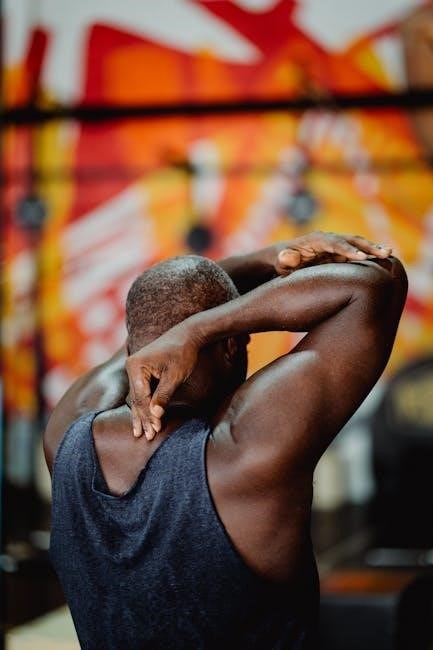Shoulder stabilization exercises are essential for enhancing scapular control and rotator cuff strength, preventing injuries and improving joint stability. These exercises are designed for athletes, individuals with shoulder pain, and post-surgical rehabilitation, focusing on proper posture and dynamic movements to ensure long-term shoulder health.
1.1 Importance of Shoulder Stability
Shoulder stability is crucial for preventing injuries, enhancing athletic performance, and maintaining proper joint alignment. It ensures the scapula and humerus function in harmony, reducing the risk of impingement and chronic pain. Strong shoulder stability promotes efficient movement patterns, protects the rotator cuff, and supports overall upper body strength. Without proper stability, daily activities and sports can lead to strains or long-term damage, emphasizing the need for targeted exercises to strengthen the muscles around the shoulder joint and improve scapular control.
1.2 Overview of Shoulder Stabilization Exercises
Shoulder stabilization exercises are a combination of strength, flexibility, and control exercises targeting the scapula, rotator cuff, and surrounding muscles. These exercises aim to improve joint mechanics, prevent injuries, and enhance athletic performance. They progress from basic scapular stabilization to dynamic movements, ensuring optimal shoulder function. Key exercises include scapular retractions, prone scaption, and wall slides, which help maintain proper alignment and reduce injury risks. Consistent practice of these exercises is essential for achieving long-term shoulder health and stability.

Phases of Shoulder Stabilization Exercises
Shoulder stabilization exercises progress through four phases, starting with basic scapular stabilization, then strengthening the rotator cuff, advancing to dynamic stabilization, and finally functional exercises.
2.1 Phase I: Basic Scapular Stabilization
Phase I focuses on building foundational scapular stability through exercises like scapular retractions and shoulder blade squeezes. These movements strengthen the muscles around the shoulder blade, improving posture and reducing injury risk. Patients are taught to maintain proper form, engaging the scapula without shrugging. Wall slides and prone scapular exercises are also introduced to enhance scapular control. This phase lays the groundwork for more advanced movements by ensuring the scapula moves efficiently and maintains proper positioning during arm activities.
2.2 Phase II: Strengthening the Rotator Cuff
Phase II focuses on strengthening the rotator cuff muscles, including the supraspinatus, infraspinatus, teres minor, and subscapularis. Exercises such as internal and external rotations using Therabands or light weights are introduced. Emphasis is placed on controlled movements to avoid impingement. Standing forward flexion (full-can exercise) and prone scaption (Ys) are also incorporated to enhance dynamic stability. This phase builds on the scapular stability achieved in Phase I, progressing to more challenging movements that improve strength and coordination for functional activities.
2.3 Phase III: Dynamic Stabilization Exercises
Phase III introduces dynamic stabilization exercises to enhance the shoulder’s ability to maintain stability during movement. Exercises like the clock exercise and resistance band rotations challenge the rotator cuff and scapular muscles in dynamic scenarios. These movements improve proprioception and functional strength, preparing the shoulder for real-world activities. Emphasis is placed on controlled, precise movements to ensure proper form and prevent compensation patterns. This phase bridges the gap between basic strengthening and advanced functional exercises, fostering greater shoulder resilience and coordination.
2.4 Phase IV: Advanced Functional Exercises
Phase IV focuses on advanced functional exercises that mimic real-life movements and sports-specific actions. Activities like overhead presses, weighted scapular stabilizations, and dynamic rotations are introduced to challenge the shoulder in complex patterns. These exercises aim to restore full functional capacity, preparing the individual for unrestricted activity. Progression is gradual, ensuring the shoulder remains stable and strong during high-demand tasks. This phase emphasizes integration of strength, flexibility, and coordination, achieving optimal shoulder performance for daily activities or athletic endeavors.

Key Shoulder Stabilization Exercises
Scapular Retraction, Prone Scaption, Standing Forward Flexion, and Wall Slides are fundamental exercises. These movements improve posture, enhance rotator cuff strength, and reduce injury risk by stabilizing the shoulder joint effectively.
3.1 Scapular Retraction (Shoulder Blade Squeezes)
Scapular Retraction strengthens the muscles between the shoulder blades, improving posture and stability; Stand tall, squeeze shoulders back, and hold for 5 seconds. Perform 3 sets of 10 reps. Keep abs tight and avoid shrugging. This exercise enhances scapular control and reduces injury risk. It’s a foundational movement for shoulder health, often used in rehabilitation and strength programs. Proper form ensures effectiveness and prevents strain. Regular practice improves joint stability and overall shoulder function.
3.2 Prone Scaption (Ys)
Prone Scaption involves bending at the waist with the affected arm hanging straight down. Raise the arm in a “Y” shape, keeping the elbow straight, to shoulder height. Hold for 2-3 seconds, then lower slowly. Perform 3 sets of 10 reps. This exercise strengthens the rotator cuff and scapular muscles, improving posture and reducing shoulder pain. It’s essential to maintain proper form and avoid lifting the arm too high. Regular practice enhances dynamic stability and promotes overall shoulder health.
3.3 Standing Forward Flexion (Full-Can Exercise)
Stand with good posture, raise your arm forward to shoulder height, keeping it straight. Hold for 2-3 seconds, then slowly lower it. Avoid raising above shoulder level. Perform 3 sets of 10 reps. This exercise strengthens the shoulder muscles and improves stability. It’s effective for overhead activities and injury prevention. Proper form is crucial to avoid impingement. Regular practice enhances strength and dynamic control, making it ideal for rehabilitation and daily shoulder maintenance. Ensure slow, controlled movements for optimal results.
3.4 Wall Slides
Stand with your back against a wall, feet shoulder-width apart. Slowly slide your arms upward, keeping your shoulders down and away from your ears. Hold for 5 seconds, then lower your arms. Repeat 10-12 times. Ensure proper posture throughout. This exercise improves scapular control and shoulder stability, reducing the risk of impingement. Focus on controlled movements to maximize effectiveness. Wall slides are ideal for strengthening shoulder muscles and enhancing dynamic stability, making them a valuable addition to any shoulder rehabilitation or strengthening program.

Dynamic Shoulder Stabilization
Dynamic shoulder stabilization focuses on enhancing joint stability through controlled movements, improving scapular control and rotator cuff function during active exercises, ideal for athletes and rehabilitation.
4.1 Clock Exercise for Scapular Control
The clock exercise is a dynamic stabilization drill that enhances scapular control and shoulder stability. Imagine a clock face on the side of your shoulder. Start with shoulders relaxed, then raise them toward the “12 o’clock” position, holding for 2 seconds. Next, lower them to “9 o’clock,” squeezing your shoulder blades together. Perform this movement slowly and controlled, avoiding shrugging. This exercise improves scapular mobility and strength, essential for dynamic shoulder stability. It is often recommended in rehabilitation programs to restore proper shoulder mechanics and prevent injuries. Regular practice enhances overall shoulder function and posture.
4.2 Resistance Band Exercises for Dynamic Stability
Resistance band exercises are effective for enhancing dynamic shoulder stability by strengthening the rotator cuff and scapular muscles. Using a Theraband, perform exercises like shoulder rotations, scapular retractions, and controlled arm movements. These exercises provide external resistance, promoting muscle activation and improving joint stability. Start with light resistance and progress gradually. Focus on maintaining proper form and avoiding momentum. Regular practice with resistance bands enhances dynamic control and reduces injury risk, making them a versatile tool for shoulder rehabilitation and strength training programs. Consistency is key to achieving lasting benefits.
Role of the Rotator Cuff in Shoulder Stability
The rotator cuff plays a crucial role in shoulder stability by providing dynamic control and preventing excessive joint movement. Its four muscles work synergistically to stabilize the shoulder joint, ensuring proper mechanics and reducing injury risk during movements.
5.1 Strengthening the Four Muscles of the Rotator Cuff
Strengthening the four rotator cuff muscles—supraspinatus, infraspinatus, teres minor, and subscapularis—is vital for shoulder stability. Specific exercises like prone scaption (Ys), side-lying external rotations, and internal rotations target these muscles. Using Therabands or light weights for resistance helps improve strength and endurance. Proper form and controlled movements are essential to avoid injury and maximize effectiveness. Progressing exercises gradually ensures balanced development and enhances overall shoulder function, reducing the risk of impingement and instability.
5.2 Integrating Rotator Cuff Exercises into Daily Routine
Consistency is key when incorporating rotator cuff exercises into daily routines. Start with simple exercises like shoulder blade squeezes and progress to more dynamic movements. Schedule exercises during daily breaks or right after warm-ups to build a habit. Use reminders or a workout planner to stay consistent. Tracking progress and celebrating small milestones can motivate adherence. Over time, these exercises become second nature, enhancing shoulder stability and reducing injury risk. Regular practice ensures long-term benefits for overall shoulder health and functionality.
Equipment for Shoulder Stabilization Exercises
Therabands and foam rollers are essential tools for shoulder stabilization exercises, providing resistance and aiding in scapular mobility and muscle recovery to enhance overall shoulder function.
6.1 Use of Therabands for Resistance Training
Therabands are versatile, lightweight resistance bands ideal for shoulder stabilization exercises. They provide adjustable tension, allowing for progressive strengthening of the rotator cuff and scapular muscles. Portable and cost-effective, Therabands enable users to perform exercises like shoulder rotations, scapular retractions, and dynamic movements. They are widely recommended for home programs and clinical settings to enhance shoulder stability and strength without bulky equipment; Their ease of use and adaptability make them a cornerstone in shoulder rehabilitation and fitness routines.
6.2 Benefits of Using a Foam Roller
A foam roller is a valuable tool for improving shoulder mobility and reducing muscle tension. It helps release tightness in the shoulder muscles, enhances blood circulation, and prepares the muscles for exercise. Regular use can improve posture, reduce injury risk, and promote recovery. It’s especially effective for targeting areas around the scapula and rotator cuff, making it a complementary addition to stabilization exercises. Incorporating a foam roller into routines enhances overall shoulder health and exercise performance.

Warm-Up and Cool-Down Routines
Begin with 5-10 minutes of low-impact activity like walking or cycling to warm up. Post-exercise, stretch to improve flexibility and reduce muscle tension, enhancing recovery.
7.1 Pre-Exercise Warm-Up Tips
A proper warm-up enhances blood flow and prepares muscles for exercise. Start with 5-10 minutes of light cardio, such as cycling or brisk walking. Incorporate dynamic stretches like arm circles and shoulder rolls to activate the rotator cuff and scapular muscles. Maintain good posture throughout to avoid strain. Avoid static stretches, as they can reduce muscle activation. End with gentle movements specific to the exercises you’ll perform, ensuring your shoulders are ready for stabilization work.
7.2 Post-Exercise Stretching Exercises
After completing your shoulder stabilization exercises, a cool-down routine with stretching is crucial to relax muscles and improve flexibility. Spend 5-10 minutes stretching the rotator cuff, shoulders, and scapular region. Include stretches like the cross-body stretch for the rotator cuff and child’s pose to release tension in the upper back. Hold each stretch for 20-30 seconds to maximize relaxation. Maintain proper posture during stretches to avoid strain. Avoid bouncing or overstretching, as this can cause muscle imbalances or injury.
Additional Tips for Effective Shoulder Stabilization
Maintain proper posture, avoid shrugging, and use Therabands for resistance. Focus on controlled movements and deep breathing to enhance stabilization and prevent fatigue or injury.
8.1 Maintaining Proper Posture During Exercises
Maintaining proper posture during shoulder exercises is crucial for effectiveness and safety. Stand tall with shoulders rolled back and down, avoiding slouching or leaning. Engage core muscles to support the lower back and promote stability. Keep the head in a neutral position, avoiding tilting or straining. Proper alignment ensures that the exercises target the correct muscles, enhancing strength and stability while minimizing the risk of injury or strain. Consistent posture habits contribute to long-term shoulder health and optimal exercise outcomes.
8.2 Avoiding Common Mistakes in Shoulder Exercises
Common mistakes during shoulder exercises include shrugging shoulders, using momentum, and overextending the neck. Avoid letting shoulders rise toward ears, as this can strain muscles and reduce exercise effectiveness. Keep movements controlled and slow, focusing on proper form. Refrain from holding breath; instead, breathe naturally to maintain relaxation and stability; Preventing these mistakes ensures targeted muscle engagement and reduces injury risk, promoting safe and effective shoulder stabilization. Consistency in avoiding errors fosters better outcomes and long-term shoulder health.
